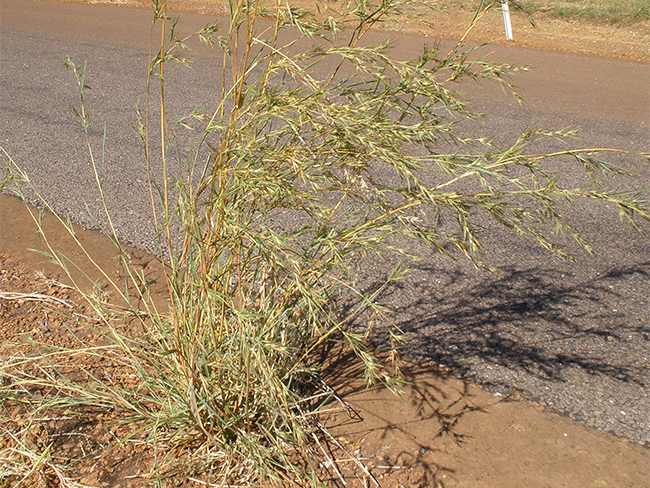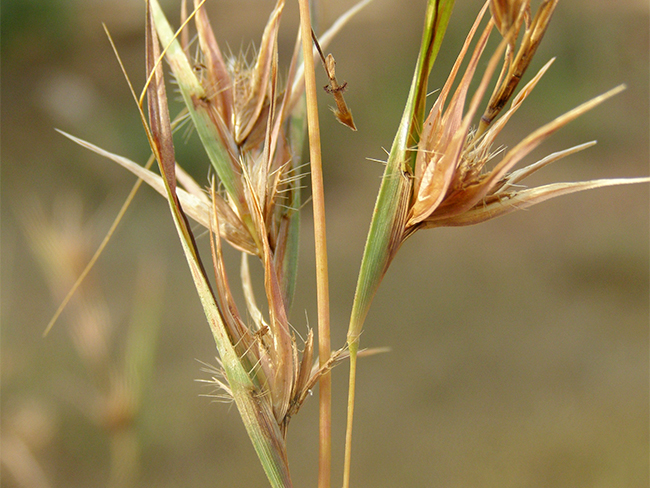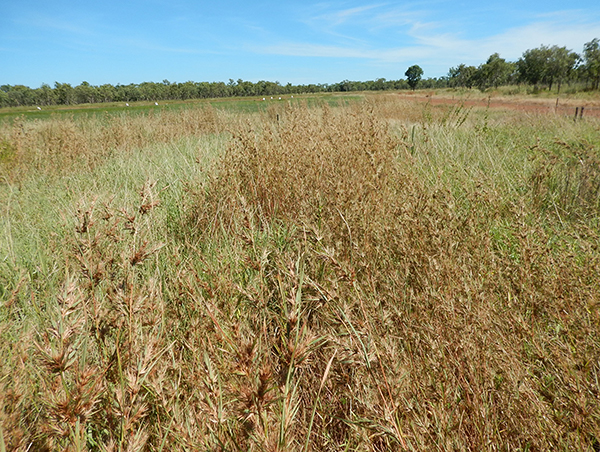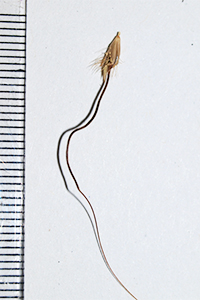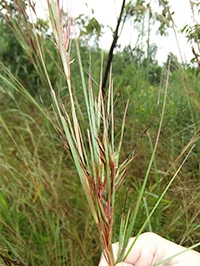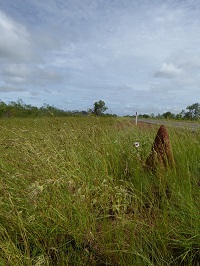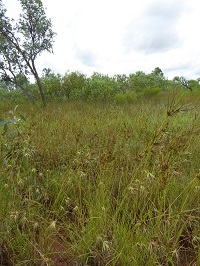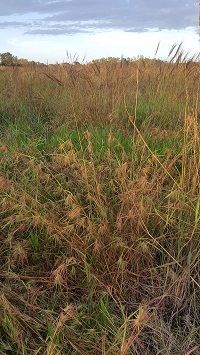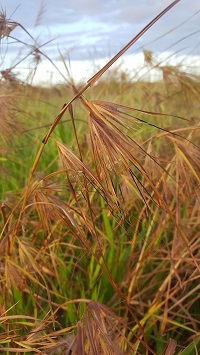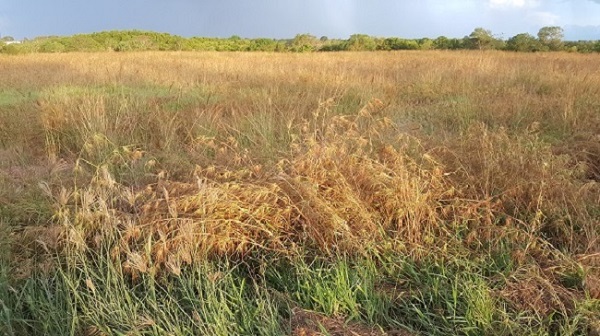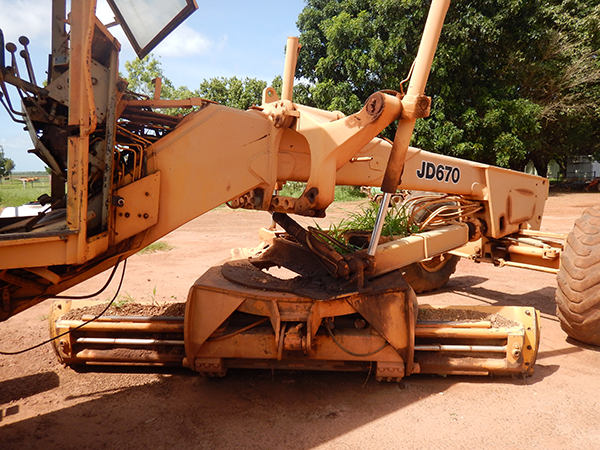Grader grass
Scientific name: Themeda quadrivalvis
Declaration status: Class B
Grader grass has a statutory weed management plan that outlines the legal requirements for control.
Get the plan on the Territory Stories website. You can also get a summary review of the plan.
Grader grass is native to India. It was accidentally introduced to Australia in the 1930s as a contaminant in pasture seed, and then in the 1960s to the Northern Territory.
It is now well-established in the Katherine and Darwin regions and continues to spread.
Grader grass has spread rapidly along the east coast of Queensland, as well as into drier inland areas. It is now a major weed, especially in northern and coastal central Queensland where infestations continue to expand.
For more information, get the:
Impact
In the semi-arid monsoonal areas of northern Australia grader grass has the potential to be a significant threat to productivity.
Grader grass can have all of the following impacts:
- invades native and improved pastures
- forms virtual monocultures
- competes with pasture species in over-used or disturbed areas
- can lead to a loss of productivity and increased fire risk
- proliferates and spreads along and from roads.
Identification
You should use this as a guide. There may be other plants or weeds that look similar.
- grows to 2m high, often in dense patches
- clumps range from having only a few stems up to 10 or more with robust, cane-like stems
- flowers occur in complex triangular-shaped or fan-shaped clusters, 1cm to 3cm long
- spikelets have distinct, bulbous-based bristles that appear in the seed head and are 4mm to 7mm long
- up to 1,000 seeds in one seed head
- mature stands turn golden-red or orange.
If you're unsure, contact the Weed Management Branch.
Similar looking plants
While it is very important to control grader grass on your property, it is also important to avoid accidentally removing certain beneficial native grasses that will compete with the invasive weeds and help the native bush to regenerate.
The following plant species look similar to grader grass:
Kangaroo grass (Themeda triandra) is a native grass that looks like grader grass. Kangaroo grass is often smaller (about 1m tall) and turns brown when mature rather than golden.
Christmas grass (Themeda arguens) is a large short-lived (eg. annual) grass growing up to 3m tall. Its individual flower spikelets are around 6 to 11mm long, hairy and topped with a large and robust awn (50 to 90mm long).
Control
Identification of grader grass before seeding can be difficult.
Small infestations should be controlled manually, preferably before seeding.
There is only a short window of opportunity to control grader grass as seed heads can appear within 5 to 6 weeks of germination, with mature seed being present after 10 weeks.
If seed is present, burn it inside a drum to generate enough heat to kill the seeds. In the event that grader grass goes to seed before control, recording the location of infestations will enable early control during the next growing season. For large infestations contact the Weed Management Branch for options.
Chemical control
The best time to treat grader grass is from December to March. Below is a list of treatment methods that can be used.
| Chemical and concentration | Rate | Situation, method and notes |
|---|---|---|
|
Glyphosate 360 g/L Various trade names and formulations | 10ml / 1L |
Seedling or adult (individuals or infestation): Foliar spray - apply when actively growing |
Non-chemical control
Hand pulling and grubbing
Weeds, including their roots, are physically pulled out of the ground by hand or using hand tools. This is an effective method of control for individual weeds and recent outbreaks that haven’t released seeds yet, but it requires a lot of labour.
Slashing
A brush-cutter, slasher or mower are used to cut weeds off above the ground level. This can be effective in suppressing flower and seed development, however grader grass is known to increase germination after slashing, possibly due to the removal of plant cover allowing seeds to germinate more easily.
Stock removal
Removing stock from areas which have been treated for weeds is a common management technique used by land managers.
This can be done in short periods (pasture spelling), or it can be a reduction in stock numbers rather than complete removal.
Supplementary feeding will also reduce grazing pressure on the land and allow the re-establishment of desirable plants which will compete with the undesirable weeds.
Spread
The spread of grader grass is often caused by contaminated pasture seed and movement by wind and water.
Burning or mowing may increase germination and cause spread.
Seeds can be transported long distances by graders, mud stuck to animals or machinery, or as a contaminant in pasture seed or hay.
Spread prevention
You can prevent the spread of grader grass by doing all of the following:
- map infestations to help develop a management plan
- control minor infestations, isolated outbreaks or seedlings first
- designate wash down areas and actively work to prevent contamination of clean areas
- ensure contractors and machinery operators are familiar with hygiene protocols and weed identification
- ensure machinery entering and leaving your property is clean
- monitor areas that you have treated and watch for re-infestations.
Give feedback about this page.
Share this page:
URL copied!
